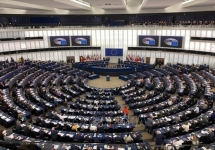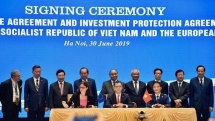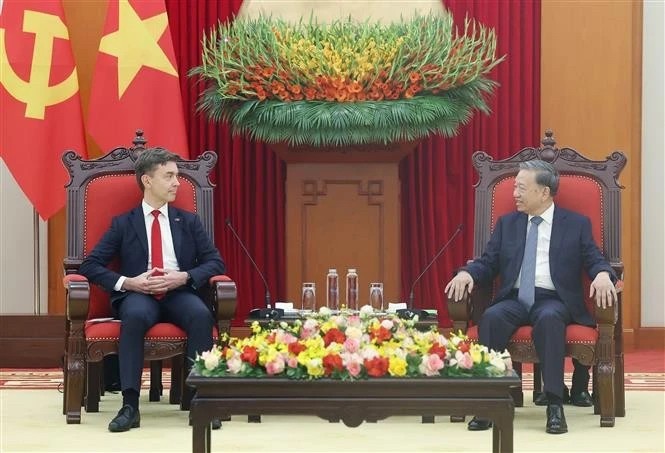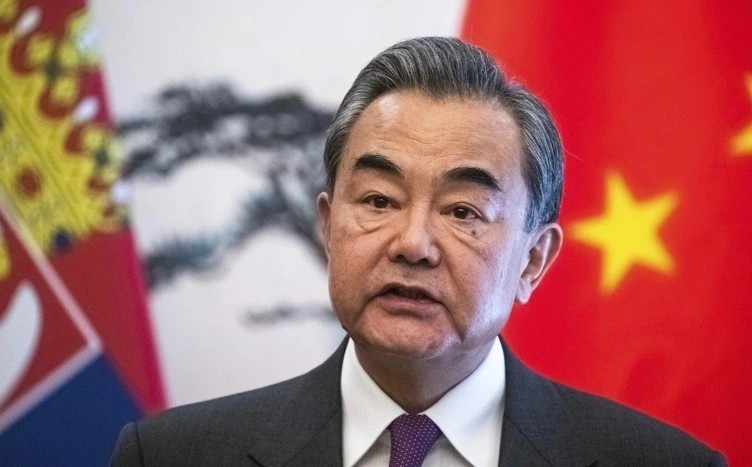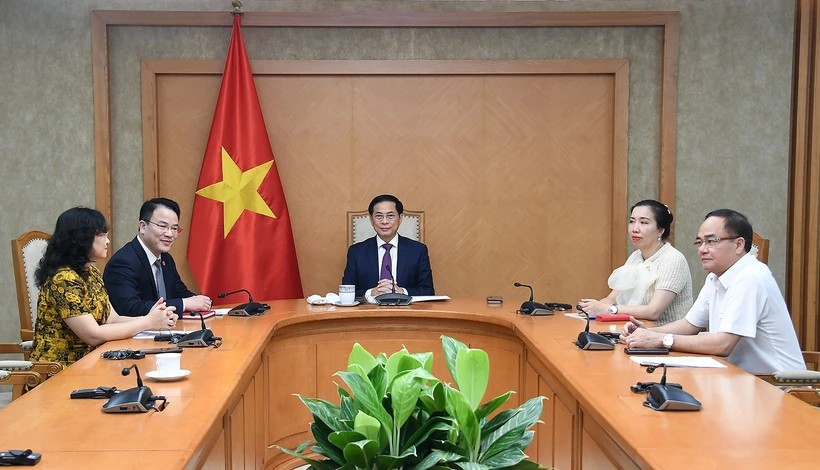Ten years of efforts to seek for “sweet fruit” EVFTA
| EVFTA brings chances and challenges to local agricultural production | |
| Czech, German media spotlight EP’s approval of agreements with Vietnam | |
| European Parliament ratifies EU-Vietnam trade pact |
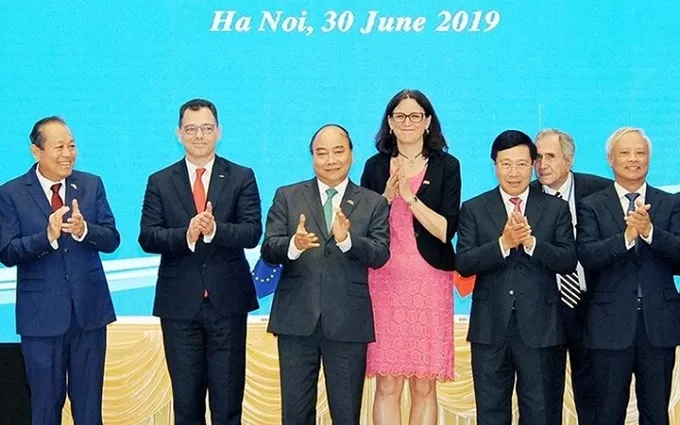 |
| Prime Minister Nguyen Xuan Phuc (third from left) and delegates attend the signing ceremony of the EVFTA in Hanoi on June 30, 2019. |
A decade of unceasing efforts
In October 2010, Vietnam and the EU agreed to start negotiations on the EVFTA). Following nearly a decade with dozens of fierce negotiations and a huge workload, on February 12, 2020, the EP officially ratified the EVFTA and the EVIPA.
The “sweet fruit” EVFTA came as a result of the entire political system’s involvement, with the joint efforts made by ministries, sectors and individuals.
Looking back to the signing ceremony of the two agreements in Hanoi last year, Prime Minister Nguyen Xuan Phuc, at that time, was on an important working trip to attend the G20 Summit and pay an official visit to Japan. Amidst his busy schedule, the Government leader returned from Japan to witness and deliver a speech at the signing ceremony, and then immediately took a flight back to Japan during the night.
Nicolas Audie, President of the European Chamber of Commerce (EuroCham) in Vietnam, said that the EVFTA and EVIPA journey is the crystallisation of a decade of relentless efforts. En route to that “sweet fruit”, both sides had to go through a long path of negotiation with countless challenges.
Touching on the past difficult path, Vu Tien Loc, Chairman of the Vietnam Chamber of Commerce and Industry (VCCI), recalled that there were moments of deadlocks in the signing and ratification process of the two deals. The negotiation process was difficult, but the ratification process seemed even tougher, because European parliamentarians are quite fastidious and have many different views and requirements, especially on the issues of human rights, labour and environment.
It can be said that at present, the legal system of Vietnam has satisfied those requirements and ensured compliance with the conventions of the International Labour Organization (ILO). In particular, Vietnam approved its accession to the ILO’s Convention 98 on collective bargaining in June 2019 and adopted the revised Labour Code in November 1919, which helped to remove important bottlenecks and created a premise for the EP to support Vietnam.
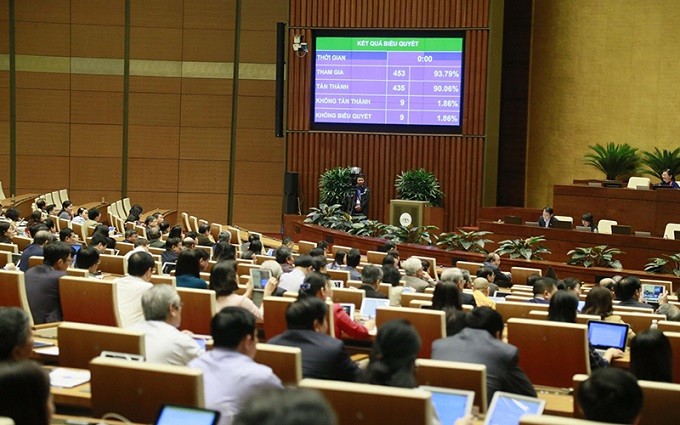 |
| The Vietnamese National Assembly adopts the revised Labour Code in November 2019. |
Luong Hoang Thai, Director of the Multilateral Trade Policy Department, Ministry of Industry and Trade, said that the most difficult time in the EVFTA negotiation process came in ending the negotiation.
It was an extremely complicated period. As the negotiations on a free trade agreement were set to conclude, the deal was forced to be separated into two new agreements, including the EVFTA and EVIPA, at the internal request of the EU, so that they would be sent to the EU member countries for approval.
“It seemed like when we’ve nearly completed a marathon race, we are forced to do it again. At that time, many of us were tired, but still we kept trying thanks to the strong determination of the entire political system, especially the Government, the Prime Minister, ministries and sectors,” Thai said.
“We then exerted greater efforts and underwent many difficult steps to mobilise EU member states to approve the EVFTA before achieving the ratification at the EP which features many different parties and ideas.”
It is worth mentioning that this is the first agreement the EU has signed with a developing country and also the first agreement that the new parliament of the EU has ratified. Vietnam overcoming these very difficult stages to achieve success is a very memorable event, particularly in the context of increasing trade protection movements in the world.
Improving quality of human resources to leapfrog opportunities
The EVFTA is opening a great opportunity for Vietnamese businesses to penetrate into a potential market with 508 million people and a gross domestic product (GDP) of roughly US$18 trillion. According to estimates of the European Commission (EC), when the EVFTA comes into force, the EU’s annual GDP will expand by US$30 billion.
A research of the Ministry of Planning and Investment shows that Vietnam’s export turnover to the EU will increase by about 20% in 2020, 42.7% in 2025 and 44.37% in 2030, compared to the no-EVFTA scenario. Some sectors are also predicted to see growth in their exports to the EU, including rice, up 65% by 2025; sugar, up 8%; forestry, up 3%; cattle and poultry meat, up 4%; beverages and cigarettes, up 5%; textiles, up 67%; apparel, up 81%; and footwear, could even be up 99%.
It can be affirmed that the EVFTA will provide great incentives for Vietnamese goods, especially for a number of industries such as garment & textile, footwear, electronics or wood products. However, some areas are forecasted to face difficulties, such as chemicals, means of transport, iron and steel, pharmaceuticals, and processed agricultural products.
In addition, the content of the agreement’s provisions contains high requirements concerning origin, certification of origin or a range of other issues, namely food safety and hygiene, information transparency and the production environment.
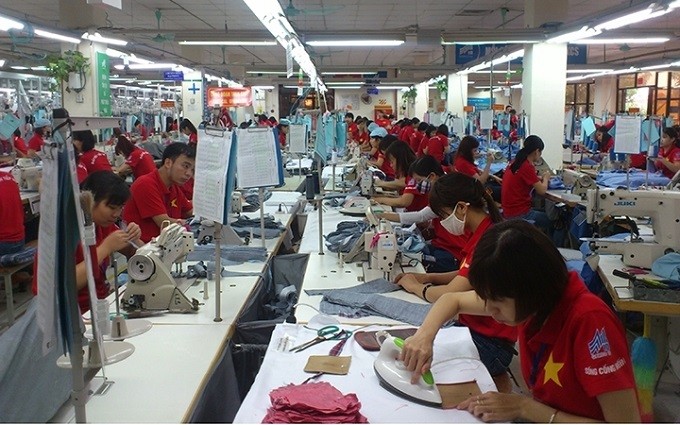 |
| The EVFTA has opened up new opportunities for Vietnam's garment & textile industry. |
Commenting on opportunities and challenges when the EVFTA is implemented, VCCI Chairman Vu Tien Loc said that after the deal comes into effect, up to 70% of goods are entitled to tax reduction, and 99.7% of import tariffs on Vietnamese commodities will be eliminated by the EU. This is a huge advantage in terms of costs when tariffs no longer matter. But in order to be eligible for such incentives, an extremely arduous journey still remains for Vietnam.
Firstly, Vietnam will have to satisfy the rules of origin of goods. At present, Vietnam’s raw materials for production mainly come from China and ASEAN, instead of from inside the country and the EU. How to meet the origin requirements is the first obstacle that Vietnamese companies need to overcome, especially for textile & garment and footwear, the two key export items of Vietnam to the EU market.
Strict technical barriers and regulations on epidemiological hygiene are also the challenges when few Vietnamese firms can easily meet them, in addition trade remedies to protect consumers and the market and the competitiveness of Vietnam’s products and services.
“At present, the competitiveness of Vietnam’s economy and Vietnamese enterprises is still at an intermediate level in the rankings of the World Economic Forum. Competing against Europe means to compete with the economies of leading competitiveness in the world. So, improving the competitiveness of Vietnamese goods and services is the most important requirement,” said Loc.
In addition, according to the VCCI chairman, a major bottleneck that Vietnam should focus on promoting is the quality of its human resources, to take advantage of integration opportunities and enhance competitiveness. Regarding the issue, Loc emphasised the need to make more innovative efforts in the areas of vocational training and higher education./.


